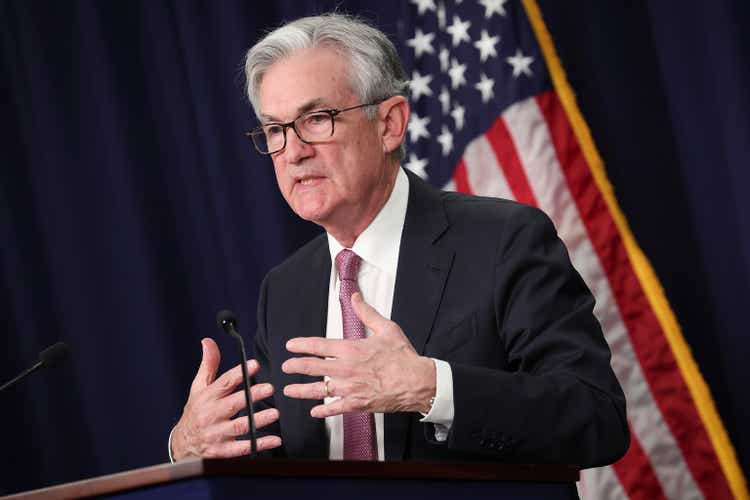Win McNamee
Fed Chair Jerome Powell’s Finest Hawkish Moment
The FOMC delivered and did not disappoint. We had already prepared ourselves for a hawkish Fed through the end of 2023, with the Fed’s revised median terminal rate of 5.1% slightly ahead of the economists’ consensus.
Hence, the critical question is whether the Fed is committed to maintaining its inflation target of 2%, even as Fed Chair Jerome Powell brushed off any suggestion of a change.
Some commentators suggested that the Fed’s credibility could be tested, as they view the target as “no longer credible.” For example, Pershing Square Capital Management founder Bill Ackman articulated that the Fed should adjust its target, seeing 3% as a viable target, as “businesses need price stability, but can thrive in a world with 3% stable inflation.”
Notwithstanding, former Treasury Secretary Lawrence Summers applauded the Fed’s decision to keep to its 2% inflation target. Summers articulated that “[he’s] gratified to see the ways in which the Fed has caught up.”
The Fed’s revised summary of economic projections (SEP) suggests its PCE inflation forecasts have been raised to 2.1% by 2025 from its previous 2% projections in September. However, market forecasters are debating whether the Fed has incorporated the latest CPI report into its SEP, given the short notice from November’s CPI release (December 13) to Powell’s presser (December 14).
UBS Securities economist Alan Detmeister articulated that the Fed’s SEP indicates that “[it has] extremely strong December numbers for inflation written in.” However, the timing of November’s CPI print might not have been reflected accordingly, even though Powell maintained in the pressor that such data points had been considered. Detmeister highlighted:
Very few of them would have probably gone ahead and updated their submissions and really worked out what it would’ve taken in December to hit that target. – Bloomberg
Is The Fed Willing To Drive A Deep Recession?
Hence, investors looking through the recent media releases and commentary from economists and market strategists are likely more confused as they parse whether the Fed could be “bluffing.”
RBC chief US economist Tom Porcelli even argued: “This aggressive hiking cycle is going to cause some damage. The Fed will cut rates twice in 2023.”
Sure, bulls think that the Fed could be forced to cut rates, as even its revised SEP suggests a recession is looking increasingly likely. However, Powell declined to predict whether one could occur, emphasizing he doesn’t have a crystal ball. Still, BofA strategists stressed that they see the potential for a “Fed policy mistake driving hard landing.”
However, Edward Yardeni maintained his call in his December 15 briefing that the Fed’s “soft-landing forecast makes sense to us.”
Therefore, we believe investors have likely gleaned a series of confusing commentary rather than clarity as strategists and economists assess whether the Fed could force a recession to keep its commitment to pressing down inflation.
Furthermore, S&P Global highlighted in a recent commentary that it sees inflationary pressures abating across the US economy, including services. It articulated:
We got the steepest downturn we’ve seen since the global financial crisis, if the initial lockdown period is excluded. The good news is that this downturn in the economy is alleviating inflationary pressures. – WSJ
Hence, could the Fed’s head be turned, even as it expects to continue hiking rates through the end of 2023? Would the Fed be responsive enough to a potential policy error that could drive the economy to a deeper downturn than the FOMC had planned for?
Even Summers has not ruled out that the labor market could be hit with a “particularly sharp weakening,” helping to alleviate one of the most consistent drivers of inflation markedly.
The Market Was Already Primed For A Pullback, Regardless
However, despite the sharp recovery in October and the positive CPI print on Wednesday, we believe that market operators were never in doubt. The market was well-primed for a pullback. We also articulated in a recent commentary after the release of November’s CPI metrics to our members:
The market is still primed for a pullback. I [have already] revised the short-term market bias on November 22 to Bearish. We got the [initial] pullback, but it wasn’t enough on the medium-term chart. So, [on December 12], I revised [the short-term bias] to Neutral to reflect the recent pullback [as] short-term indicators [are] no longer overbought. But, with yesterday’s [December 13, post-CPI release] possible bull trap price action, I’ve revised it down one notch to Bearish-Neutral for our short-term bias. I will discuss this in more detail after we get more clarity on today’s FOMC presser. – Ultimate Growth Investing December 14 – Pre-market briefing
That’s right. The market has drawn in investors astutely into FOMO mode as they feared they missed its October lows. We highlighted to our members on October 21 that “we have the bullish reversal condition that we need. So, we are good to go.” During those days, we vividly recall that the media and strategists were highly pessimistic.
We even highlighted in October to members that “money managers are sitting on the highest levels of dry powder waiting to be deployed in twenty years.” Therefore, we aren’t surprised that Bloomberg reported:
After a month of drawing down positions, investors poured $25 billion in stocks in the week through Wednesday only to see the S&P 500 plummet as the Federal Reserve and other central banks stuck with hawkish stances that threaten to spur a recession. – Bloomberg
Takeaway
Recall we mentioned that we revised our short-term market bias to Bearish on November 22, nearly four weeks ago. The market had prepared for this moment for a while, drawing in unsuspecting retail/institutional investors into FOMO, anticipating the Santa Claus rally to unfold.
Our suggestion is this: Be wary. The pullback is likely far from over, and where it takes us next could portend whether October lows could be sustained. And don’t FOMO again.


Be the first to comment